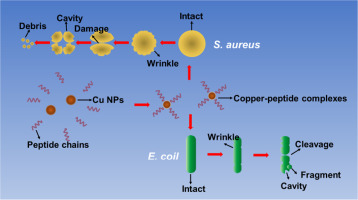Biomaterials Advances ( IF 5.5 ) Pub Date : 2020-01-14 , DOI: 10.1016/j.msec.2020.110669 Pengzhao Lv , Lianjie Zhu , Yanmiao Yu , Wenwen Wang , Guokai Liu , Hongguang Lu

|
A series of Cu nanoparticles (NPs) have been prepared by a facile hydrothermal method at 180 °C using different concentrations of NaOH solutions and characterized by XRD, SEM, TEM and FT-IR spectra. Their antibacterial activities were assessed by means of Gram-positive S. aureus and Gram-negative E. coli bacteria, where various dosages (3, 5, 7, 10 mg) of the antibacterial agents were applied, and compared with that of the commercial CuSO4 salt. The antibacterial mechanism was explored based on series of control experiments. The results show that the NaOH concentration affects the crystallinity, crystal size and surface hydroxyl content of the Cu NPs, which significantly influence the antibacterial activities. Compared to the commercial CuSO4 salt, the four Cu samples prepared using no <4 mol L−1 of NaOH display excellent antibacterial activities with low concentrations of copper leachates, which is great beneficial to the practical applications. The experimental results support that the highly reactive and soluble copper species in the antibacterial system of the Cu NPs is a Cu (II)-peptide complex, but not free Cu2+ ions.
中文翻译:

NaOH浓度对Cu纳米颗粒抗菌活性的影响及抗菌机理
通过使用不同浓度的NaOH溶液于180°C的水热法制备了一系列的铜纳米颗粒(NPs),并通过XRD,SEM,TEM和FT-IR光谱进行了表征。通过革兰氏阳性金黄色葡萄球菌和革兰氏阴性大肠杆菌对它们的抗菌活性进行了评估,分别使用了各种剂量(3、5、7、10 mg)的抗菌剂,并与市售的抗菌剂进行了比较。 CuSO 4盐。基于一系列的对照实验探索了抗菌机理。结果表明,NaOH浓度会影响Cu NPs的结晶度,晶体尺寸和表面羟基含量,从而显着影响抗菌活性。与商用CuSO 4相比盐,四个铜样品使用无<4摩尔100μl制备- 1的NaOH显示与低浓度的铜浸出液,这是很大的实际应用中是有益的优异的抗菌活性。实验结果表明,Cu NPs抗菌系统中的高反应性和可溶性铜是Cu(II)-肽络合物,而不是游离的Cu 2+离子。











































 京公网安备 11010802027423号
京公网安备 11010802027423号